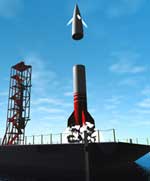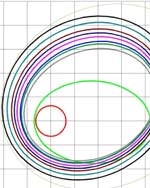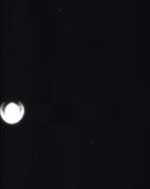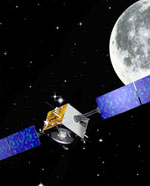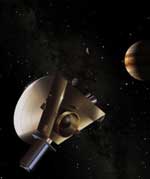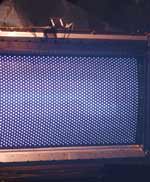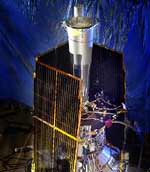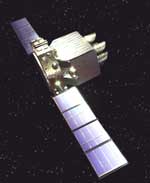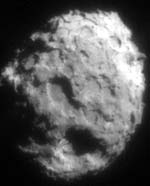
Image credit: NASA/JPL
When NASA’s Stardust spacecraft swept past Comet Wild-2, it captured material from the comet’s tail and revealed incredible details about the surface of the fast moving object. The few images that Stardust was able to take also provided some surprises. Scientists anticipated that that comet would be a dusty snowball, with very few surface features, but Stardust found impact craters, barn-sized boulders, and tall cliffs. This indicates that the comet isn’t the loose collection of material that scientists theorized, since it’s obviously withstood quite a beating.
On Jan. 2nd, 2004, NASA’s Stardust spacecraft approached Comet Wild 2 and flew into a storm. Flurries of comet dust pelted the craft. At least half a dozen grains moving faster than bullets penetrated Stardust’s outermost defenses. The craft’s 16 rocket engines struggled to maintain course while a collector, about the size of a tennis racquet, caught some of the dust for return to Earth two years hence.
All that was expected.
Then came the surprise. It happened when Stardust passed by the core of the comet, only 236 km distant, and photographed it using a navigation camera. The images were intended primarily to keep the spacecraft on course. They also revealed a worldlet of startling beauty.
Right: The nucleus of Comet Wild 2 photographed by Stardust with approximately 20 meter resolution. Click on the image to see a much larger version.
At the heart of every comet lies a “dirty snowball,” a compact nucleus of dust and ice that the sun vaporizes, little by little, to form the comet’s spectacular tail. These nuclei are hard to see. For one thing, most are blacker than charcoal; they reflect precious little sunlight for cameras. Plus they’re hidden deep inside a cloud of vaporizing gas and dust, called “the coma.” Stardust’s plunge into Wild 2’s coma allowed it to view the nucleus at close range.
Previous flybys of Comet Halley by the European Giotto probe and Comet Borrelly by NASA?s Deep Space 1 revealed lumpy cores without much interesting terrain–as expected. These comets have been sun-warmed for many thousands of years. Solar heating has melted away their sharpest features.
Comet Wild 2, however, looks different. “We were amazed by the feature-rich surface of the comet,” says Donald Brownlee of the University of Washington, the mission’s principal investigator. “It is highly complex. There are barn-sized boulders, 100-meter high cliffs, and some weird terrain unlike anything we’ve ever seen before. There are also some circular features,” he adds, “that look like impact craters as large as 1 km across.”
“The high cliffs tell us that the crust of the comet is reasonably strong,” notes Brownlee. It’s probably a mixture of fine-grained rocky material held together by frozen water, carbon monoxide and methanol. Certainly a lander could touch down there, or an astronaut could walk across the surface without worrying too much about the ground collapsing.
An astronaut standing on Comet Wild 2 would see a truly fantastic landscape, speculates Brownlee. ?I imagine them inside one of the craters, surrounded by deep cliffs.” Icy spires, as tall as a person, might rise out of the crater floor. “These would be be the comet-equivalent of ‘snow spikes’ on Earth–those little jagged ridges that form when snow is exposed to sunlight and melts.”
Getting out of the crater would be easy. “Just jump,” says Brownlee, “but not too hard.” The comet?s gravity is only 0.0001-g, so “you could easily leap into orbit.”
Some of the photos from Stardust reveal gaseous jets. “The jets come from active regions on the comet’s surface, fissures or vents probably, where the ice is vaporizing and rushing into space,” Brownlee says. This is how mass is transferred from the comet’s nucleus to its tail.
Viewed from the surface, the jets would be nearly transparent. But an astronaut could spot them by looking for “dust entrained with the gas. Dust grains glinting in the sunlight would look like tracer bullets shooting out of the ground.”
A careful explorer could survey the entire 5-km nucleus in only a few hours, leaping high above the surface, dodging the occasional jet. “What an experience that would be,” he says.
There are billions of comets in the solar system. “We’ve gotten a close-up look at only three,” says Brownlee. And one of the three, Comet Halley, presented its night side to the cameras. So it’s too soon to say whether Comet Wild 2, among comets, is truly unusual.
Unlike comets Halley and Borrelly, notes Brownlee, “Wild 2 is a very recent arrival to the inner solar system.” For billions of years it orbited in the cold deep space beyond Jupiter, until 1974 when it was nudged by Jupiter’s gravity into a sun-approaching orbit. Since then the comet has passed by the Sun only five times; solar heating is only beginning to mold its surface.
And, according to Brownlee, that might be the key to the comet’s appearance. “Wild 2’s surface is a mixture of young and old that we haven’t see before,” he explains. Young features include possible sinkholes collapsing as the terrain is warmed. Impact craters and their ejecta, on the other hand, are old scars from time spent in the outer solar system.
The old parts of Wild 2 are what make the comet an attractive target for the Stardust probe, which captured a thousand or more grains of comet dust during the flyby. Such material, little altered since the formation of the solar system, could tell us a great deal about our origins.
The craft’s payload will return to Earth in 2006 for analysis by scientists. If a single picture from the navigation camera can surprise researchers, just imagine what’s in store when they get their hands on a thousand pieces of the comet itself.
Original Source: Science@NASA
